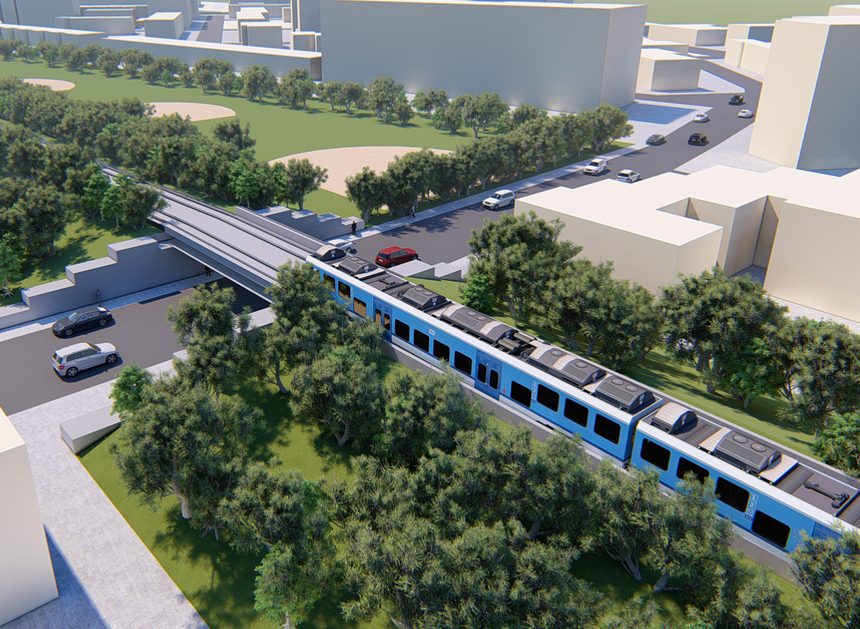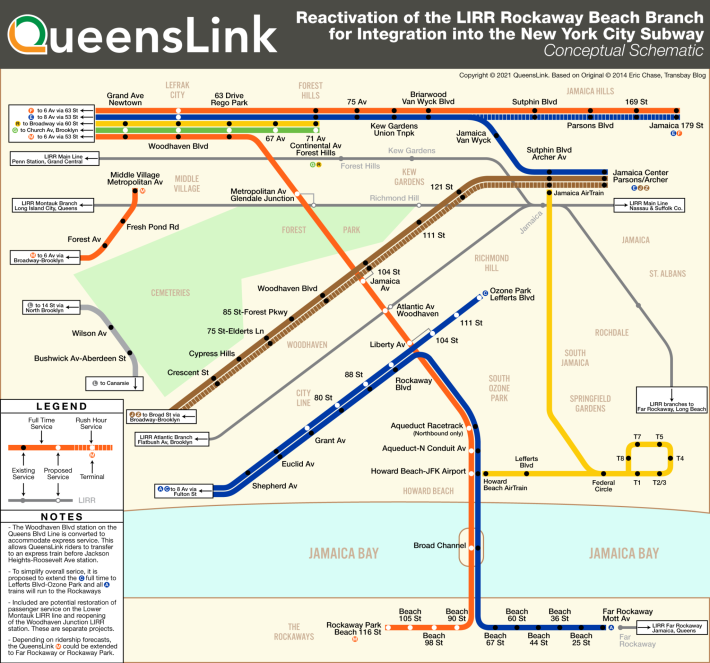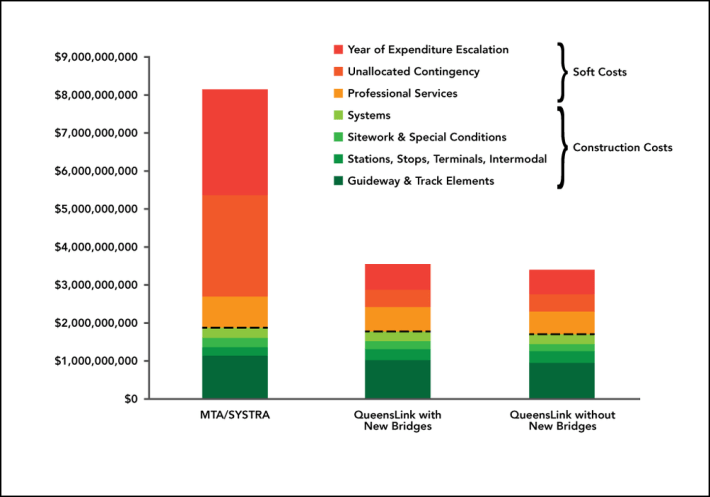MTA Hiked Costs of Long-Sought Eastern Queens Subway Expansion: Report
12:14 AM EDT on July 14, 2021

Tim is . Photo: QueensLink
An MTA consultant slapped a ridiculously high pricetag on a project to add subway service to eastern Queens by using abandoned Long Island Rail Road tracks — and now supporters of the so-called QueensLink have put out their own study suggesting the service expansion could be finished for half as much as the MTA said.
The new, independent report on a combination park/transit option takes the MTA to task for letting a consultant tell the authority that sprucing up the abandoned LIRR right of way and building four new subway stations would cost a whopping $8.1 billion. According to an engineering firm hired by QueensLink supporters, the project could be done for between $3.4 and $3.7 billion.
The abandoned right of way in question is a 3.5-mile stretch of tracks between Ozone Park and Rego Park that used to be part of the LIRR's Rockaway Beach Branch. Service on the rails ended in 1962, and the tracks have sat unused since. The MTA report, prepared by SYSTRA Engineering, looked at either restoring LIRR service to the existing tracks or using the rail infrastructure to create a north-south subway link, but the QueensLink report focused on using the right of way to build a four new stops on north-south subway link that supporters say could move Queens residents between south and central Queens and provide transfers to multiple subway and LIRR lines.

QueensLink supporters also used their report as an olive branch for a competing campaign to turn the abandoned railway into a Queens version of the High Line, which park supporters call the Queensway. Per the QueensLink report, there's a chance to both reopen train service using the right of way and create 33 acres of park space and bike paths alongside the train infrastructure.
The MTA's notoriously high construction costs aren't even at the center of the dispute between the advocates and the authority. Both the original report looking at ways to restart service on the abandoned tracks and the new study peg the cost of the actual construction at about $1.8 billion.
The two reports wildly diverge when it comes to soft costs (any costs not directly related to physical construction), cost increases from any sudden changes to the project and whether the SYSTRA correctly calculated what inflation-adjusted costs would turn out to be.

QueensLink supporters say that SYSTRA used formulas that drove non-construction costs to a stratospheric $6.3 billion for things like contractor and contingency fees. They also accuse SYSTRA of pricing the entire project in inflation-adjusted terms of 2030 dollars instead of how much inflation over the life of the project would add to the price overall.
Rails plus trails supporter Andrew Lynch said he was unsurprised by the result of the competing study, but is still struggling to understand why the agency tried to sabotage the idea.
"We know that the costs were inflated but we don’t have a smoking gun showing why they were inflated," said Lynch. "The MTA has been very tight-lipped about the report. We suspect the MTA never really wanted the report released and only did it because they were obligated to by the state. The report was released a year after it was supposedly finished. We suspect everything was intentional but we don’t know why.
The MTA report on reviving the tracks was approved in 2016 and assigned to SYSTRA Engineering in 2017. But even though the study was finished in 2018, the MTA didn't publicly release it until pressure to do so mounted on the authority in 2019. When that report was finally made public, transit observers suggested the MTA simply didn't want to do the project, so it accepted the outrageous price tag as a way to sap public support for it. The new report could be seen as a way to revive that public interest, and has at least one Queens elected official perking up and asking questions.
"Queens Borough President Donovan Richards is in contact with the QueensLink team and looks forward to convening a meeting with the MTA so we can learn how they determined this figure," said a spokesperson for Richards.
It will take more than just the Queens BP to get the project off the ground though. Former Federal Transit Administration employee Larry Penner said that the QueensLink reporter was a well-researched and argued document, but that the multibillion dollar project still needs more champions and a more regional interest to get off the ground.
"You need a project sponsor to apply for Federal Transit Administration funding," said Penner. "There is no indication that the MTA or NYCDOT is interested in pursuing funding. This would include entering the project into the FTA New Starts program. Both Governor Cuomo and Mayor de Blasio have programmed no additional funding to advance this project. I'm not aware of Senator Schumer, Gillibrand or any local member of Congress requesting any formula or earmarked federal funding for years."
The MTA declined to comment on the report.
The activists' concern that the MTA is using the inflated price tag in their commissioned report is reminiscent of how the supporters of a bike and pedestrian path on the Verrazzano Narrows Bridge felt after the MTA commissioned a report only to abandon further consideration when the cost appeared too high, as Streetsblog reported. In that case, documents obtained by Streetsblog under the Freedom of Information Law, show that the agency did not seriously consider two proposals by the bridge’s original designers to create simple and cost-effective routes for non-car users on the bridge and instead substituted a bloated plan costing hundreds of millions more.
Dave Colon is a reporter from Long Beach, a barrier island off of the coast of Long Island that you can bike to from the city. It’s a real nice ride. He’s previously been the editor of Brokelyn, a reporter at Gothamist, a freelance reporter and delivered freshly baked bread by bike. Dave is on Twitter as @davecolon. Email Dave Colon at dcolon@streetsblog.org
Stay in touch
Sign up for our free newsletter
More from Streetsblog New York City
Thursday’s Headlines: Speed-Limiting Tech Edition
State Sen. Andrew Gounardes continues his push to force reckless drivers to install speed limiters in their cars. Plus more news.
DOT Official: All Our Free Parking Justifies Keeping Curb Space for EVs
If only someone could do something about the parking!
New York City to Install 500 Secure Bike Parking Hubs In The Next Five Years: Sources
Your bike may finally get a roof over its head.
Adams Backs Lower Speed Limits, Calls Crashes ‘Accidents’
The mayor wants New York City drivers to "slow down," but it's not clear yet how many streets will get lower speed limits.
Wednesday’s Headlines: Trump Posts About Congestion Pricing Edition
Donald Trump comments on congestion pricing — no surprise, he's against it. Plus more news.




